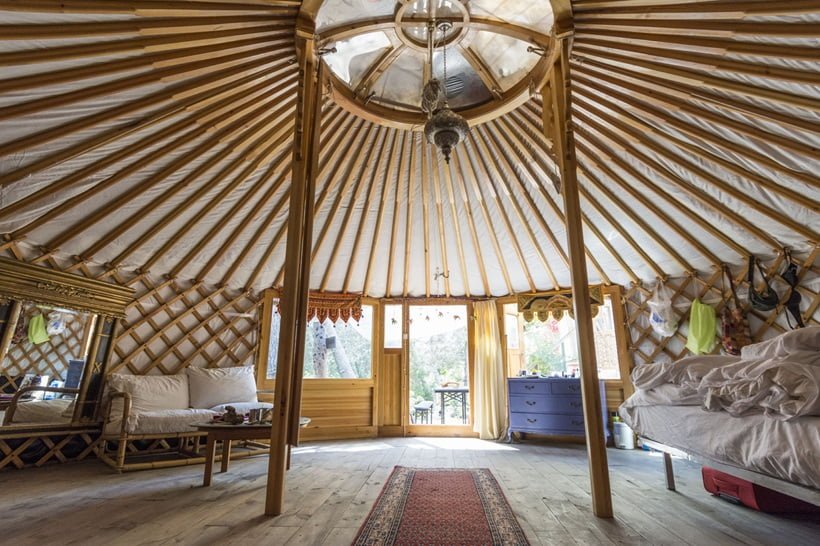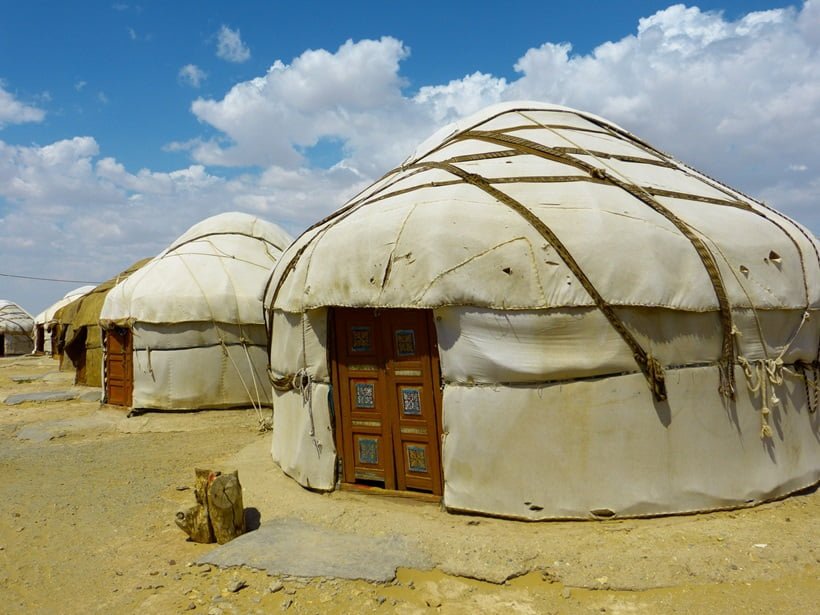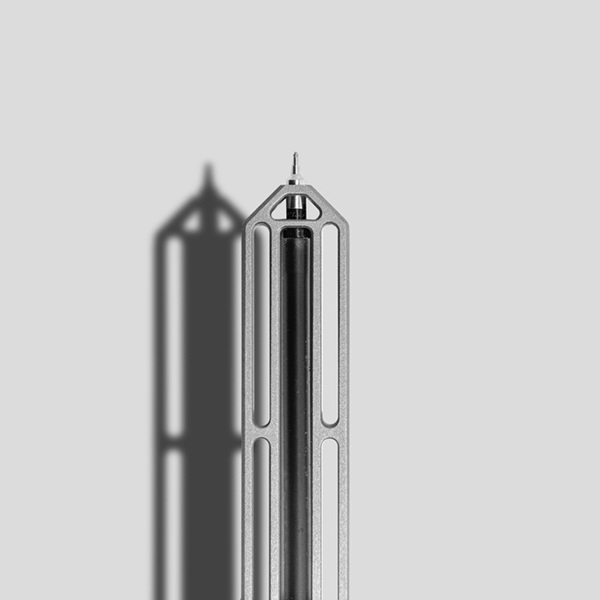
Would you like to experience one of the most unique vacation types? If yes, you can embark on a unique adventure with yurt camping, where modern comfort meets rustic charm. Yurts provide a cozy yet spacious retreat. In addition, it is ideal for those who seek an escape from the hustle and bustle of daily life.
These circular, tent-like structures were traditionally used by Central Asian nomads. Right now, a yurt tent offers a sustainable and immersive way to experience the great outdoors. In addition to all that, camping in a yurt ensures a comfortable stay in any season. It is perfect for families, couples, and solo travelers. As yurt camping combines the serenity of nature with the convenience of home, you will experience an unforgettable experience.
If you are eager to learn more about glamping yurt vacations, you can check out our guide below.

What is a Yurt?
Nomads in Central Asia used to build portable and round tents to stay in during your rest time. In addition, these nomads were using these portable yurts to withstand harsh climates. On the other hand, modern camping yurt tents maintain this unique structure but are often enhanced for comfort. Modern ones also feature wooden frames, insulated walls, and skylights.
Yurt camping tent It is also ideal for eco-friendly camping in addition to its unique blend of nature and luxury. These sturdy, spacious shelters provide a cozy retreat, complete with amenities like beds, stoves, and furniture. It is even possible to find a yurt with a hot tub! Now, you can understand why we consider yurt camping a unique experience!
If you are looking for an off-the-grid experience without sacrificing comfort, a yurt is a great option for you.

The History of Yurts
Did you know that the history of yurt camping tent dates back over 3000 years to the nomadic tribes of Central Asia, particularly in Mongolia? These portable and circular dwellings are designed for relaxation and mobility. Such structures were essential for the harsh climates and the nomadic lifestyle. The word “yurt” itself is derived from the Turkish word “yurt,” meaning “home” or “homeland.” This word reflects the deep cultural significance of these structures.
Nomads traditionally constructed these yurts with a wooden frame and covered them with sheep’s wool. Because sheep’s wool provided excellent insulation against extreme temperatures, The nomads could easily assemble and disassemble the frame, which consisted of a lattice wall and roof poles. Such quick relocation allowed nomads to move with the seasons and follow their herds and resources.

Why are Yurt Tents Circular?
The shape of the yurt is not only structurally efficient but also symbolically significant. The round shape represents harmony, unity, and the cyclical nature of life. Of course, over the centuries, yurt style tents evolved and incorporated regional variations and improvements. However, it retained its core design principles.
In recent years, the campground with yurts concept has gained popularity beyond Central Asia. Right now, people around the world embrace the sustainability and unique aesthetic of this tent design.

How to Camp in a Yurt
If you go on a vacation at a campground yurt, you can experience a unique and comfortable outdoor experience. However, it requires some preparation. Unlike traditional camping, yurts involve specific gear and planning to ensure a smooth stay.
As a yurt camper, you need to bring appropriate bedding, cooking equipment, and weather-appropriate clothing. In addition, you need to plan your activities, such as hiking, fishing, or stargazing, to enhance your experience.
In addition to all this, you need to prepare yourself for problems like adapting to limited amenities and unpredictable weather conditions. With proper preparation and a flexible mindset, yurt camping can provide an unforgettable and enriching outdoor experience for all types of adventurers.

Yurt Camping Gear List
Although yurts provide a solid structure, there are essential items to pack to make your stay seamless.
Bedding: While some yurts may have basic beds or cots, bring your own sleeping bags, blankets, and pillows for extra warmth and comfort. An air mattress or camping pad can also enhance your sleeping arrangements.
Cooking Supplies: Yurts may have basic cooking facilities, but it’s wise to pack a portable camping stove, cookware, utensils, and a cooler for food storage. Don’t forget matches, a lighter, and a fire extinguisher for safety. Additionally, you can bring biodegradable soap, a sponge, and a basin for washing dishes.
Lighting: Pack headlamps, lanterns, and extra batteries to illuminate the yurt and its surroundings at night. While some yurts have solar-powered lights, having backup lighting is essential.
Clothing: The weather can be unpredictable, so you should bring layers to stay warm, dry, and comfortable. Include moisture-wicking shirts, thermal layers, waterproof jackets, and sturdy hiking boots. Don’t forget hats, gloves, and extra socks.
Personal Items: Pack toiletries, a first-aid kit, insect repellent, and sunscreen. Consider bringing a portable charger or power bank for electronic devices, especially if the yurt lacks electricity.
Outdoor Gear: Depending on your planned activities, you might need hiking gear, fishing equipment, or binoculars for birdwatching. A foldable camping chair can also be useful for relaxing outside the yurt.
Cleaning Supplies: Bring a small broom and dustpan to keep the yurt tidy, along with trash bags for waste disposal.
Activities During Yurt Camping
If you would like to open up a world of unique and exciting activities, yurt camping can be a great way to start. You can blend the traditional and distinctive charm of camping activities. Here are some activities to consider while yurt camping to enhance your experience.
- Hiking and nature walks
- Wildlife watching
- Fishing and boating
- Stargazing
- Campfire gatherings
- Photoography
- Relaxation and meditation
- Outdoor games
- Board games
Challenges of Yurt Camping
Yurt camping offers a unique and enriching outdoor experience, but it also comes with its own set of challenges. You should understand and prepare yourself for these potential obstacles to make your stay more enjoyable and stress-free. Some of the common challenges of yurt camping are summarized as follows:
Weather Conditions
One of the primary challenges of yurt camping is dealing with unpredictable weather. Yurts provide more shelter than traditional tents, but they may still be vulnerable to extreme temperatures, strong winds, and heavy rainfall. To prepare yourself for weather challenges, you should check the weather forecast before your trip and pack accordingly.
For example, you can bring layered clothing to adjust temperature changes and thermal wear for cold nights. In addition, you can wear breathable fabrics on hot days. Lastly, a waterproof jacket and extra tarps can help protect against rain.
Limited Amenities
Yurts may lack some of the amenities found in modern camping facilities, such as running water, electricity, and indoor plumbing. This can make daily tasks like cooking, washing, and charging devices more challenging.
To prevent any negative experience, you can bring your portable camping stove, water containers, and a solar charger or power bank. In addition, you should plan your meals ahead of time to simplify cooking.
Lastly, you can use biodegradable soap and a basin for washing dishes. A portable toilet can be a useful addition if the campsite lacks facilities.
Wildlife Encounters
Yurt camping in natural settings increases the likelihood of encountering wildlife. While this can be a highlight of the experience, it also poses risks, especially with animals like bears or raccoons attracted to food.
Store food securely in bear-proof containers or hang it from a tree away from the yurt. Keep your campsite clean, dispose of trash properly, and avoid leaving food scraps around. You can also familiarize yourself with local wildlife and follow guidelines to minimize risks.
Insects and pests
Insects such as mosquitoes, ticks, and flies can be a nuisance during your stay. They can disrupt sleep and pose health risks through bites and stings. Therefore, you should pack insect repellent, citronella candles, and bug nets for protection. You can also wear long sleeves and pants, especially during peak insect activity times.
Lack of privacy
Yurts are typically located in shared camping areas, which can mean less privacy compared to more isolated camping options. Noise from other campers and close proximity can be challenging for those seeking solitude.
Choose a yurt campsite that offers more secluded spots or book during off-peak times to reduce crowding. Use earplugs or white-noise apps to block out unwanted sounds. Communicate with fellow campers to establish quiet hours and mutual respect.
Setup and maintenance
While yurts are easier to set up than traditional tents, they still require some effort to assemble and maintain. An incorrect setup can lead to instability and discomfort.
Follow the setup instructions carefully, ensuring all components are securely fastened. Regularly check for wear and tear and make necessary repairs to maintain the yurt’s integrity. Familiarize yourself with basic maintenance tasks to handle any issues that arise.
Limited Space
Despite being more spacious than tents, yurts can still feel cramped, especially with multiple occupants and gear. This can lead to a lack of organization and clutter.
Maximize space by using storage solutions like hanging organizers and compact furniture. Keep belongings tidy and designate specific areas for different activities, such as sleeping, cooking, and lounging. Pack only essential items to avoid overcrowding.














